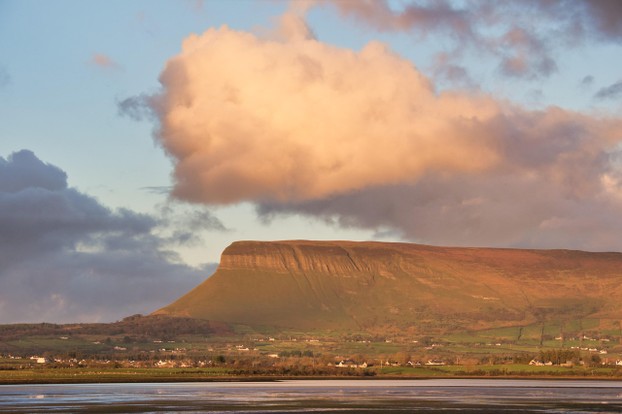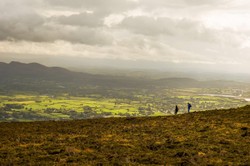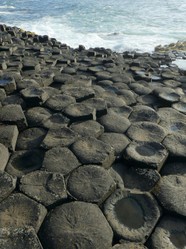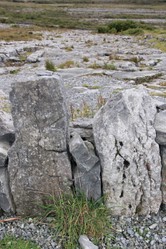The Irish word lough is closely related to the Scottish Loch and the English word lake. There are attractive loughs in the county, one of which is Lough Gill, which is conveniently set near Sligo City, making it a pleasant recreational area. The lough is mainly in county Sligo, but a part of it lies in the neighbouring county of Leitrim. The circumambulation of the lough takes roughly an hour, but there are a range of footpaths allowing walkers to create their own diversions. The waters of Lough Gill are remarkably clean and free from pollution, making Lough Gill a good place for swimming. But a word of warning is apt: the lake bed is rocky, so diving is not advised. A word of advice. Do not confuse Lough Gill in Sligo with Lough Gill in Kerry.
Lough Gill has literary affiliations, for it was Lough Gill that provided the inspiration for Yeats' poetic fantasy of retreating as a solitary to the idyllic Isle of Innisfree. It is possible that Yeats was inspired by the remains of crannogs still to be found in Irish loughs. These were artificial islands built out into lakes and marshes to provide security from assailants there are some of these crannogs in Lough Gill but while the islets remain the wooden structures in which people dwelt have rotted away. It is worth noting that crannogs occur in Britain as well as Ireland, so they are a feature of ancient life in these Isles. There are archaeological traces of some crannogs in Lough Gara, which straddles the boundary of Sligo and neighbouring Roscommon.
Another Sligo lough is Lough Talt up on the Ox Mountains, back in Febuary 1970 I visited Lough Talt. The weather was memorably cold and the vegetation around the lough was sparse. But the lough and its stony environs had a stark and lonely beauty to their feel, we saw no human habitation, but we knew that there was some.
The lough is home to certain endangered species. There is a population of the rare European eel, and very importantly the Arctic char, which used to be common in the British Isles, but as to be protected in its rare haunts.
The loneliness of the mountains has a positive side, for wild birds have a safe home in the area. This has resulted in the Lough Talt area being included in a wider conservation centred on Lough Hoe, which stretches through Sligo and into Mayo.
Sligo is a place with a charming character. I have enjoyed my visits there. Do ancestral voices still call?
I am an Amazon Associate and I earn money from qualifying purchases on this page






 Women of the Gospelson 10/11/2025
Women of the Gospelson 10/11/2025
 Religious Gardenson 08/25/2025
Religious Gardenson 08/25/2025
 Doctor of the Church: John Henry Newmanon 08/03/2025
Doctor of the Church: John Henry Newmanon 08/03/2025
 Restoring the Palm Houseon 07/16/2025
Restoring the Palm Houseon 07/16/2025




Comments
I have looked up the meanings. Benwisken means haystack peak, because of its pointed summit. Ben bulben means peak of the jaw. It's shape suggests a jaw or beak.
Ben means mountain or hills, but my knowledge of Gaelic names does not extend so far
The second paragraph to the first subheading, Rooted in time, advises us of Ben Bulben and Ben Wisken.
What do the two names mean in English?
The ascendancy is the upper class who dominate political and economic life. An ascendancy is not a democratic system. While there may be elected parliaments only a privileged few have a vote.
The second paragraph to the first subheading, Rooted in time, advises us that "The poet William Butler Yeats was a native of that area, though unlike my impoverished forebears he was from a wealthy ascendancy family."
What is an "ascendancy" family?
Families drift apart over time. But my sister Veronica has an interest in genealogy and family relationships and has done quite a bit of work. But she is a very busy woman, running a business and caring for family duties.
Thank you for your comment below, in answer to my previous observation and question.
It's a bit sad that you and your Ireland-inhabiting relatives know nothing about one another.
Is the afore-indicated inhibition an impossible impasse because of insufficient information?
The name Thornton came to Ireland when the parliamentary army invaded. A Thornton from that army got land, I believe. It is likely that his tenants took his surname. This has led to a situation in which there are Catholic and Protestant Thorntons. We have no contact with any relatives of my line in Ireland. All our contacts are with Maureen's kin and some in-laws in Northern Ireland linked to my brother's family
Ragnar Jónasson authored a new book last year, Death at the Sanatorium.
His hero, Helgi, conserves the bookstore-collection and personal library of his book-selling father and grandfather.
Helgi's (and Ragnar Jónasson's) favorite mystery writer is Agatha Christie. But he lists Raymond Thornton Chandler's (Jul 23, 1888-Mar 26, 1959) Philip Marlowe character as uniquely dramatized among Chandler works -- Chandler mentioned before dying not making anything for television, but making stories into films -- in a television series.
Chandler's Irish-born mother married an American even as mother and son moved to England and Ireland after a parental divorce. Two uncles maintained their sister and nephew Raymond in London and Waterford.
Might Raymond Thornton Chandler, who merited dual American and British citizenship, have been descended from the Thornton settlers in your second paragraph (and therefore among your collateral-line ancestors)?